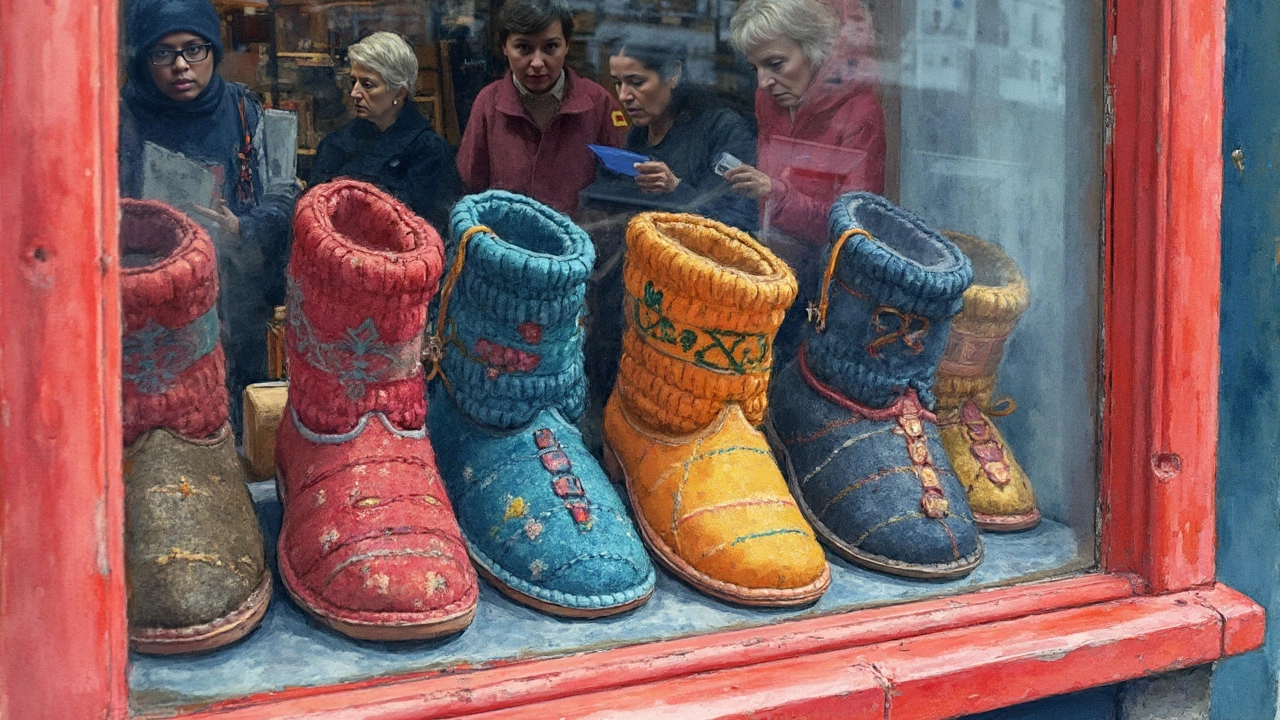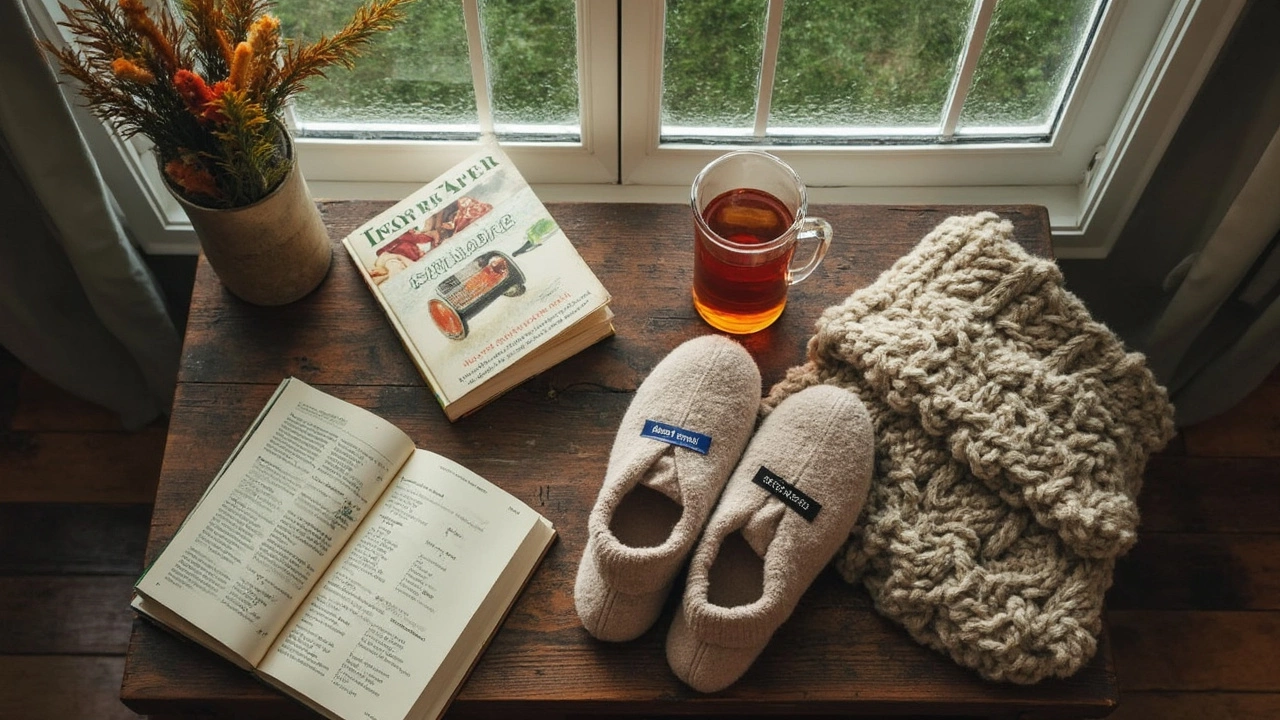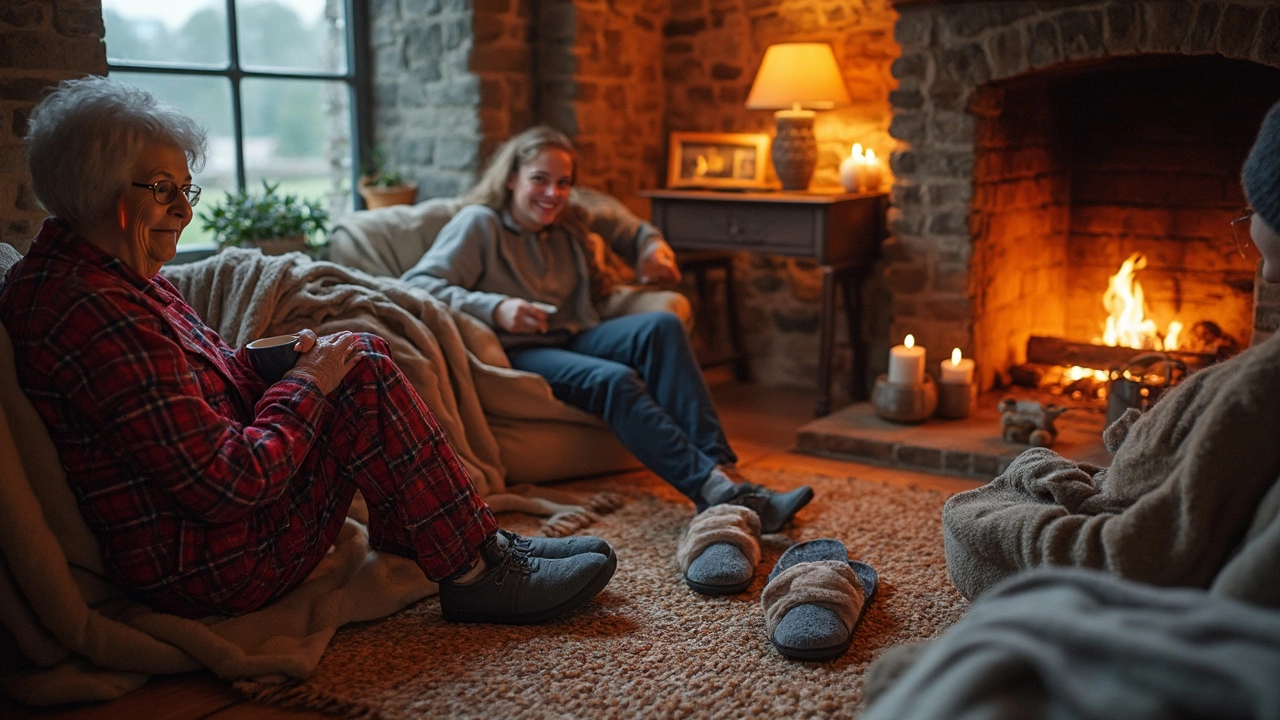Cold kitchen tiles in January, damp hallway floors, even a sudden knock at the front door — there’s a reason slippers have a special place in Irish homes. If you’re lost in a sea of options, you’re not alone. Not every pair of slippers survives the winter in Ireland; locals know a flimsy sole won’t cut it when you’re traipsing from the back garden to the kettle.
Start by thinking about the Irish climate. Damp and brisk most months, it’s definitely not sandal weather. That’s why shoppers here gravitate towards slippers with proper insulation and waterproof soles. Go for lined options — sheepskin or fleece are big winners. Ever noticed how many Irish houses drop the heating at night? Slippers almost become a necessity, not a luxury, especially in older, draughtier homes.
It’s easy to focus on looks, but be practical. You want something that grips a bit on tiled or wooden floors. Slipping and sliding in your granny’s kitchen is memorable, just maybe not in a good way. Watch out for slippers with a sturdy rubber sole. They’re better for popping out with the bins or chasing after the postie in the rain.
- Picking Slippers for Ireland’s Weather
- Top Irish Brands and Where to Shop
- What to Look for: Fit, Material, and Durability
- Tips for Every Budget
- Care, Cleaning, and Slipper Traditions
Picking Slippers for Ireland’s Weather
Let’s face it: the weather in Ireland can be soggy, chilly, and unpredictable, even in summer. This isn’t the place for flimsy flip-flops. When shopping for slippers in Ireland, you’ve got to be thinking about damp floors, draughts through old windows, and heating bills that skyrocket in the winter months.
Back in early spring, heavy downpours can still make the ground cold and wet. That transfers straight through thin soles. And do you really want to risk soggy feet when you’re just putting the kettle on? Investing in slippers with thick, water-resistant soles helps here, especially in rural areas where the back garden is never far from the kitchen door.
Some of the best slippers Ireland offers use actual Irish wool or fleece for lining. Both Glenkeen and Slugg Slippers use real sheepskin from Irish farms, which acts as a natural insulator. Local experts say wool-lined slippers keep heat in even when the air feels damp, making them especially good for draughty cottages or those cold terraced houses in Limerick or Cork.
Here’s a quick heads-up when you’re comparing slipper material:
- Sheepskin: Super warm in winter and surprisingly good at preventing your feet from getting sweaty thanks to its natural moisture-wicking.
- Fleece: Budget-friendly and soft, but not as breathable as wool. Still much better than synthetic fabric in holding up to Irish dampness.
- Rubber soles: These are a must if you do a lot of quick dashes outside, especially with Irish grass often wet nine months of the year.
A lot of Irish folks like slippers that cover the heel fully, especially in colder Ulster counties or houses with tiled floors. Open-backed slippers give zero protection when there’s a draught blowing under the door. If you’re on the east or west coast, go for closed styles that keep out the Atlantic chill.
Just how often will you use your slippers? An Irish survey from 2023 (done by a Dublin interiors shop) found that 68% of people wore their slippers for over three hours daily during winter. No wonder comfort and decent grip matter so much.
| Weather condition | Best slipper feature |
|---|---|
| Cold/damp mornings | Wool or fleece lining, closed backs |
| Rainy dashes outside | Rubber soles, water-resistant materials |
| Tile or wooden floors | Cushioned insole, grippy outsole |
Think about these things next time you’re eyeing those designer slippers with thin, pretty soles. For Irish weather, reliable warmth and something that really grips will make life a lot more comfortable.
Top Irish Brands and Where to Shop
When it comes to slippers Ireland shoppers rave about, there’s a good mix of homegrown brands and handy places to buy them. Nothing beats getting a pair that’s actually made for, and tested in, Irish conditions.
Let’s start with some familiar names. Cushendale Woollen Mills out in Kilkenny are famous for their wool slippers and booties – they use Irish fleece spun in Graiguenamanagh, and their quality really does last. Aran Woollen Mills, often spotted at gift shops or their own stores in Mayo, also knocks out solid slippers. The best Irish slippers don’t always come with a huge price; sometimes, a local chemist or even Dunnes Stores will stock hidden gems, especially around holidays like Christmas.
Don’t forget Shuul Colours, a Galway-based small brand. They’re a hit for slippers with a bit of Irish pride, coming in county GAA colours and all. If you want extra support, Greenes Shoes (with shops in Sligo, Donegal, and online) sell memory foam and orthopedic slippers that sell out fast during cold snaps.
"Irish winters can be tough on your feet, so we focus on warmth and durability over fashion. Our slippers fly off the shelf from October," says Catherine O’Brien, manager at a popular Galway shoe shop.
If you’re shopping in person, pop into Avoca in Dublin or Wicklow for luxury picks. Avoca’s slipper range often changes, but the mix of Irish-made and scandi-style cosiness means you usually find something sturdy and soft. On a budget? Many locals check TK Maxx for discounted comfort footwear, while Penneys have surprisingly decent options if you need a quick fix.
| Store/Brand | Location | Speciality |
|---|---|---|
| Cushendale Woollen Mills | Kilkenny & Online | Irish Wool Slippers |
| Shuul Colours | Galway & Online | County Colours, Irish Style |
| Greenes Shoes | Sligo, Donegal & Online | Comfort, Orthopedic |
| Avoca | Dublin, Wicklow | Luxury, Gift Slippers |
| Dunnes Stores, Penneys | Nationwide | Budget, Quick Picks |
Remember, the Irish market shifts with the seasons. You’re more likely to find good stock and the best picks from October through February. Support local when you can – it keeps the toes warm and the Irish wool industry ticking over.

What to Look for: Fit, Material, and Durability
When you’re picking out slippers in Ireland, the fit is just as important as in any good shoe. Don’t guess your size — Irish brands like Slumber Slippers and the ever-popular Dunnes usually stick closely to regular shoe sizes, so try before you buy if you can. Snug is good, but don’t squash your toes; your feet will thank you after a long, cold evening in front of the telly.
Material makes a massive difference, especially with our weather. Classic sheepskin or genuine wool slippers (think Irish-made, like The Woollen Market in Galway) naturally keep your feet warm and dry, plus they let your skin breathe. Synthetic liners sometimes overheat or get sweaty, leading to that dreaded slipper stink. Fleece and microfibre cost less and feel soft, but might not last as long as natural fibres.
As for durability, look under the hood — or, well, under the slipper. Hard rubber soles survive Ireland’s wet back gardens and run-ins with flagstones outside the door. Memory foam insoles can add comfort but might flatten out after a few months if you’re always on your feet. If you often nip outside, go for something you can wipe down fast. Below is a quick comparison of slipper materials Irish shoppers see most often:
| Material | Warmth | Breathability | Durability | Best For |
|---|---|---|---|---|
| Sheepskin/Wool | High | Excellent | High | Cold homes, all year round |
| Fleece | Good | Moderate | Medium | Quick warmth, budget-friendly |
| Microfibre | Moderate | Low | Medium | Spare pair, easy care |
| Memory Foam Sole | N/A | Depends | Medium | Extra comfort indoors |
Double-check seams and stitching if you’re shopping in-store. Loose threads mean you’ll be buying again next winter. And if you can, give them a little bend test — a flexible but sturdy sole usually handles the shuffle to the kitchen and back without falling apart.
Last little tip: go for slippers you can wash (at least the liners). A lot of Irish homes have pets and kids running in and out. Being able to freshen your best Irish slippers in the washing machine is a life-saver, especially when the bog-muddy dogs visit.
Tips for Every Budget
Let’s face it—no one wants to splash out for a pair of slippers that’ll fall apart faster than you can say “black ice on the back step.” Whether you’re a student scraping by or don’t mind paying extra for luxury, there’s a slippers Ireland option out there for you.
If you’re pinching pennies, Dunnes Stores and Penneys are a solid bet. You can get basic, comfy slippers for under €10. Sometimes you’ll even spot special offers—last February, I found perfectly good fleece-lined slip-ons in Penneys for just €6. They’re not built for running laps around the house, but they keep your toes warm until the end of the season.
Middle of the road? That’s where shops like Marks & Spencer, Arnotts, and even TK Maxx shine. Expect to pay around €15–€30 for slippers with memory foam, anti-slip soles, and sometimes even cool features like washable linings. M&S is famous with Irish shoppers for their long-lasting cozy range, and you’ll often see people pick up a fresh pair during their Christmas shop.
Want real quality, made-to-last? Look at Irish brands like Slippers.ie, West Cork’s Sheepskin Slippers, and pretty much anything from Dubarry. You’ll pay €40–€70, but you get long life and that unmistakable Irish sheep’s wool comfort. These slippers are a regular on gifting lists come birthdays and Christmas.
"There’s serious value at every price point if you shop around; cheap doesn’t have to mean nasty, but the good Irish brands do make a difference for warmth and toughness." — RTÉ Lifestyle, January 2024
Here’s a simple breakdown of what you’re likely to pay, and what you get for your money:
| Price Range (€) | Where to Buy | Features |
|---|---|---|
| 5–15 | Penneys, Dunnes, Lidl | Basic foam, fleece, seasonal styles |
| 15–30 | Marks & Spencer, Arnotts, TK Maxx | Memory foam, better grip, machine washable |
| 40+ | Slippers.ie, Dubarry, local craft shops | Sheepskin, hand-stitched, outdoor soles |
Don’t forget outlet stores and post-Christmas sales can knock down the price, too. And sometimes, honest reviews from local friends are worth more than reading through dozens of five-star global ratings. Happy feet don’t have to cost a fortune, but keep an eye out for real quality if you want slippers to last through an Irish winter or two.

Care, Cleaning, and Slipper Traditions
There’s no sense in splashing out on slippers Ireland stores love if they fall apart after a few weeks. Let’s talk keeping them fresh and lasting longer—because nobody likes pongy or grubby slippers by the fireside.
Most popular soft slippers in Ireland (think sheepskin or fleece) don’t like the washing machine. Always check the label. If in doubt:
- Whip out a damp cloth and spot clean stains—lukewarm water and a drop of mild washing-up liquid usually does the trick.
- Let them air dry inside, away from radiators. High heat can shrink the inner lining or warp soles.
- For anything especially pongy, sprinkle in bicarbonate of soda, leave overnight, then shake the powder out in the morning. It absorbs smells without fuss.
- If you’re dealing with Irish brands that use real leather or suede, a little specialist cleaning spray goes a long way.
Hard-sole slippers (the type you could nearly wear in the Spar) handle more dirt but don’t be tempted to toss them straight in with dirty socks. Dirt and wet mix into a stubborn mess. For a quick spruce up, brush away dried mud with a stiff brush and wipe down with a soapy cloth.
Wondering how long slippers really last in Irish homes? Here’s a snapshot from a recent Bord Bia household survey:
| Slipper Type | Average Lifespan |
|---|---|
| Sheepskin | 18-24 months |
| Fleece-lined | 12-18 months |
| Basic foam | 6-9 months |
Now, for the fun bit—tradition. In many Irish households, new slippers appear under the tree every Christmas. If you’ve lived here a while, you know getting a giant fluffy pair from your mam is almost as standard as socks. Many locals keep a ‘guest pair’ or two by the door, especially out West where visitors dropping by remains a thing. It’s simple: take off your shoes, grab the spare slippers, and settle in for a cuppa.
And if you’re buying them as a gift, Irish superstition says you should ask the receiver for a small coin in exchange. It’s meant to stop any bad luck—so the next time you pick up best Irish slippers for someone, ask for that five cent!
